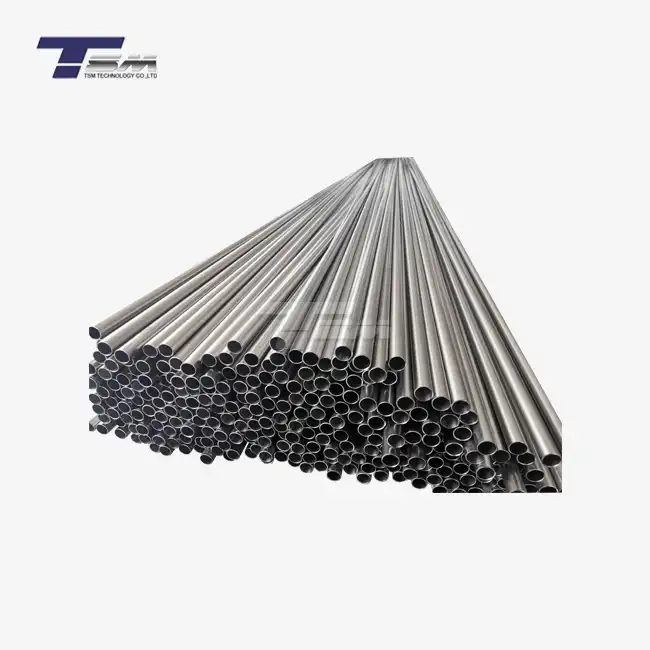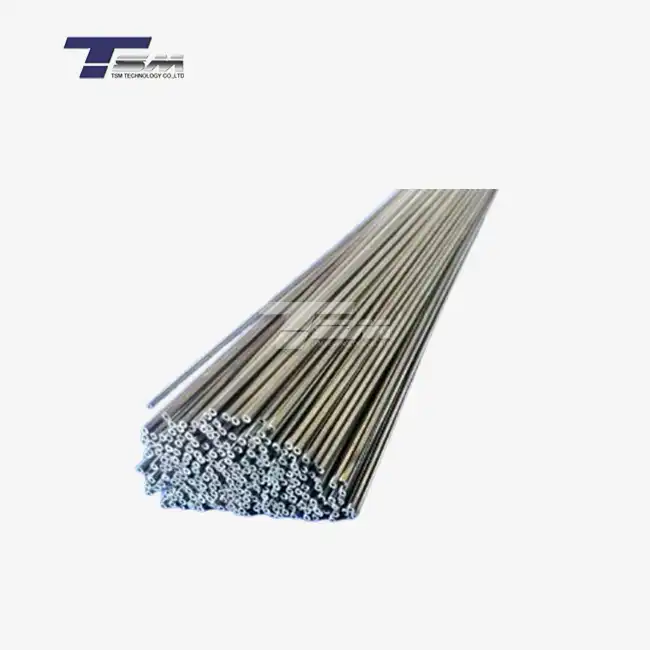The Importance of Proper Melting Techniques for Hastelloy C276
Vacuum Induction Melting (VIM) Process
The Vacuum Induction Melting (VIM) process is a cornerstone in the production of high-quality Hastelloy C276 tubes and seamless pipes. This advanced melting technique involves heating the raw materials in a vacuum environment using electromagnetic induction. The absence of atmospheric gases during melting prevents unwanted reactions and contamination, resulting in a purer alloy composition. VIM allows for precise control over the melt temperature and chemistry, ensuring that each batch of Hastelloy C276 meets exact specifications.

The benefits of VIM in Hastelloy C276 production are multifaceted. It significantly reduces the presence of impurities such as oxygen, nitrogen, and hydrogen, which can adversely affect the alloy's properties. This cleaner melt translates to improved mechanical strength, enhanced corrosion resistance, and better overall performance of the final Hastelloy C276 tubing products. The controlled environment also allows for more accurate additions of alloying elements, ensuring that the chemical composition remains consistent throughout the melt.
Electroslag Remelting (ESR) for Enhanced Purity
Following the initial VIM process, many high-quality Hastelloy C276 products undergo Electroslag Remelting (ESR). This secondary melting technique further refines the alloy, removing residual impurities and improving the material's overall cleanliness. In ESR, the VIM-produced ingot is gradually melted and resolidified under a layer of electrically conductive slag. As the molten metal passes through the slag, impurities are trapped, resulting in an even purer and more homogeneous Hastelloy C276 ingot.
The ESR process is particularly beneficial for Hastelloy C276 seamless pipes and tubes intended for critical applications. It helps eliminate macro-segregation, reduces the size and distribution of non-metallic inclusions, and improves the alloy's isotropy. These enhancements lead to superior mechanical properties, increased fatigue resistance, and improved weldability in the final Hastelloy C276 products. The combination of VIM and ESR ensures that Hastelloy C276 tubing meets the most stringent quality standards required by industries such as chemical processing, offshore oil and gas, and nuclear power generation.
Temperature Control and Solidification
Precise temperature control during the melting and solidification processes is paramount in achieving optimal Hastelloy C276 tube quality. The melting point of Hastelloy C276 is approximately 1370°C (2500°F), and maintaining the correct temperature range throughout the melting process is critical. Overheating can lead to undesirable changes in the alloy's microstructure, while underheating may result in incomplete melting and poor homogenization.
During solidification, controlled cooling rates are essential to develop the desired grain structure and prevent the formation of detrimental phases. Slow, uniform cooling promotes the formation of a fine-grained structure in Hastelloy C276, which contributes to improved mechanical properties and corrosion resistance. Advanced techniques such as directional solidification may be employed to further enhance the alloy's performance characteristics, particularly for Hastelloy C276 seamless pipes used in high-stress environments.
Chemical Composition and Its Impact on Hastelloy C276 Performance
Balancing Alloying Elements
The exceptional properties of Hastelloy C276 tubes and seamless pipes are largely attributed to their carefully balanced chemical composition. The melting process plays a crucial role in ensuring that each alloying element is present in the correct proportion. Hastelloy C276 typically contains 57% nickel, 15.5% chromium, 16% molybdenum, 4% tungsten, and small amounts of manganese, silicon, and carbon. Each element contributes specific properties to the alloy, and their precise balance is critical for optimal performance.
During melting, special attention is given to controlling the levels of carbon, silicon, and phosphorus, as these elements can significantly impact the alloy's corrosion resistance and mechanical properties. For instance, maintaining low carbon content (typically less than 0.01%) is essential to prevent carbide precipitation, which can reduce the alloy's resistance to intergranular corrosion. The melting process must ensure that these elemental compositions are achieved consistently across the entire batch of Hastelloy C276 tubing.
Microstructure Development
The melting and subsequent solidification processes directly influence the microstructure of Hastelloy C276, which in turn affects its mechanical and corrosion-resistant properties. The goal is to achieve a uniform, fine-grained austenitic structure free from detrimental phases. The cooling rate from the molten state plays a significant role in determining grain size and distribution. Controlled solidification during the melting process helps prevent the formation of undesirable precipitates and ensures a homogeneous microstructure throughout the Hastelloy C276 seamless pipe or tube.
Advanced melting techniques, such as electromagnetic stirring during solidification, can be employed to further refine the grain structure. This results in Hastelloy C276 products with improved strength, ductility, and resistance to various forms of corrosion. The refined microstructure also contributes to better fatigue resistance and creep properties, which are crucial for Hastelloy C276 tubing used in high-temperature and high-pressure applications.
Inclusion Control and Cleanliness
The cleanliness of Hastelloy C276 is a critical factor in its overall quality and performance. During the melting process, controlling and minimizing non-metallic inclusions is of utmost importance. These inclusions, which can include oxides, sulfides, and nitrides, can act as stress concentrators and initiation sites for corrosion and fatigue failures. Advanced melting techniques, such as vacuum arc remelting (VAR) in addition to VIM and ESR, can be employed to further reduce inclusion content in Hastelloy C276 tubes and seamless pipes.
The use of high-purity raw materials and stringent control over the melting atmosphere helps minimize the introduction of impurities. Additionally, techniques such as argon bubbling or electromagnetic stirring during melting can help float out inclusions, resulting in cleaner Hastelloy C276 ingots. The cleanliness achieved during melting directly translates to improved mechanical properties, enhanced corrosion resistance, and better overall performance of the final Hastelloy C276 tubing products.
Quality Control and Testing in Hastelloy C276 Tube Production
In-Process Monitoring and Control
Ensuring the quality of Hastelloy C276 tubes and seamless pipes begins with rigorous monitoring and control during the melting process. Advanced spectrometric analysis is employed to continuously monitor the chemical composition of the melt, allowing for real-time adjustments to maintain the precise alloy balance. Temperature control systems with high accuracy are utilized to maintain the optimal melting and solidification temperatures. These in-process controls are crucial for achieving consistent quality across different batches of Hastelloy C276 tubing.
Modern melting facilities often incorporate automated systems that track and record various parameters throughout the melting process. This data not only ensures adherence to quality standards but also provides valuable information for process optimization and traceability. By maintaining tight control over the melting conditions, manufacturers can produce Hastelloy C276 products with highly consistent properties, meeting the exacting requirements of industries such as chemical processing and aerospace.
Post-Production Testing and Certification
After the melting and subsequent forming processes, Hastelloy C276 tubes and seamless pipes undergo a battery of tests to verify their quality and performance characteristics. These tests include chemical analysis to confirm the exact composition, mechanical testing to assess strength and ductility, and various non-destructive tests to check for defects or inconsistencies. Corrosion testing is particularly important for Hastelloy C276, given its primary use in highly corrosive environments.
Specific tests for Hastelloy C276 tubing may include:
- Tensile testing to determine yield strength, ultimate tensile strength, and elongation
- Hardness testing to ensure consistent mechanical properties
- Ultrasonic testing to detect any internal defects
- Hydrostatic pressure testing for seamless pipes to verify integrity
- Intergranular corrosion testing to confirm resistance to this form of attack
- Pitting corrosion tests in various aggressive media
Each batch of Hastelloy C276 products is typically accompanied by detailed certifications documenting the material's composition, mechanical properties, and compliance with relevant industry standards.
Continuous Improvement and Innovation
The quest for higher quality Hastelloy C276 tubes and seamless pipes is an ongoing process. Manufacturers continually invest in research and development to improve melting techniques and refine quality control processes. This includes exploring new melting technologies, developing more sensitive monitoring equipment, and investigating novel alloy compositions that could enhance the performance of Hastelloy C276 tubing.
Collaboration between material scientists, process engineers, and end-users drives innovation in Hastelloy C276 production. Feedback from industries using these high-performance alloys informs improvements in the melting process and quality control methods. This continuous cycle of improvement ensures that Hastelloy C276 products continue to meet and exceed the evolving demands of critical applications in corrosive and high-temperature environments.
Conclusion
The role of melting in Hastelloy C276 tube quality cannot be overstated. From the initial vacuum induction melting to potential secondary refining processes, each step in the melting journey significantly influences the final product's properties. The careful control of chemical composition, temperature, and solidification conditions during melting lays the foundation for the exceptional corrosion resistance and mechanical strength that Hastelloy C276 is known for. As industries continue to push the boundaries of material performance, the importance of advanced melting techniques and stringent quality control in producing high-quality Hastelloy C276 tubes, seamless pipes, and tubing will only grow. By maintaining a focus on melting excellence, manufacturers can ensure that Hastelloy C276 products continue to meet the most demanding applications across various industries.
Contact Us
For more information about our high-quality Hastelloy C276 products and how they can meet your specific needs, please contact us at info@tsmnialloy.com. TSM TECHNOLOGY is committed to providing superior alloy solutions tailored to your requirements.

_1739071581132.webp)

